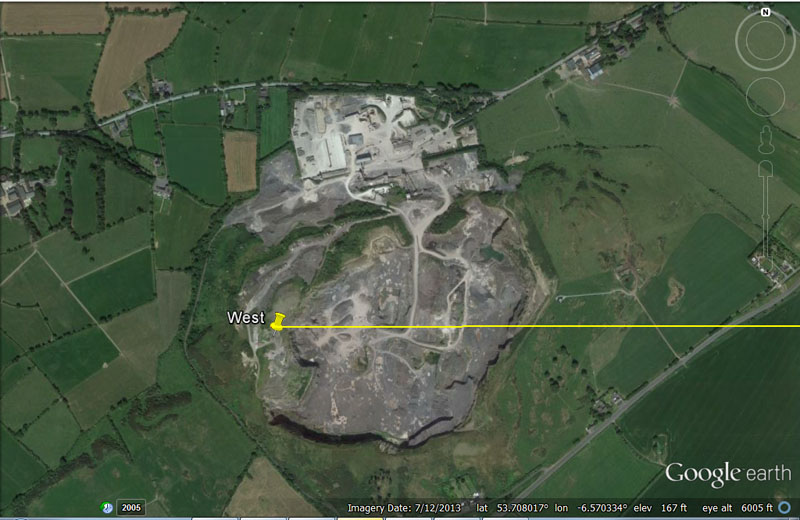
DOWTH HENGE'S TRIG FOR DUE WEST
Whereas Slieve Gullion Mountain, sitting 25-minutes of equatorial arc due North, would be often enshrouded in mist, another nearer-in target could be seen whenever the weather was half-way reasonable. This target within the Boyne River Valley provided a perfect fix on the position of due West.

Situated due West (270-degrees azimuth) an almost perfect 5 ancient Irish miles (6720' each) from the centre of Dowth Henge is the high western ridge of Carrickdexter Hill. Although lower parts of the hill to the eastern side have been quarried, the original high point of the hill appears to have escaped that indignity and is intact. It appears very likely that a pillar or cairn marker would have once sat atop this summit position, providing a finite fix on due West from the centre of the Dowth Henge.
ACCURACY
The very clear indication is that the ancient surveyors wished to achieve a distance, due North to the summit of Slieve Gullion, of 151200' or 25-minutes of equatorial arc for the Earth under a common navigational system that used a mile of 5250'. A second reading existed, simultaneously, that configured the distance to be 151250' for 25-minutes of arc, based upon a 2nd navigational system that used the slightly larger mile of 5280'. In terms of accuracy, over a distance approaching 29-miles, the shortfall onto the target was only about 150 - 200', which is remarkable.
Equally stunning is the accuracy achieved in calculating the position of true North, wherein the final error was only .08-degrees off to the East. This equates to only 2/25ths of 1-degree or about 180' to the West of the trig cairn marker atop Slieve Gullion. This level of accuracy compares very favourably with the kind of accuracy achieved in the orientation of the Great Pyramid of Egypt.
BUT IS THERE ANY SIGNIFICANCE IN THE 151200 FEET DISTANCE BETWEEN THE TWO POINTS?
Well, yes there is, and the very precise distancing, with very little room for error, demonstrates advanced surveying ability and knowledge of triangulation mathematics. It would have taken years of exploring, observation, planning and mathematical calculations before the exact epicentre position for Dowth Henge could be decided upon, as it is directly tied to the peak of Slieve Gullion Mountain by a coded angle and distance.
This exact navigational method for determining the equatorial circumference of the Earth is encoded into the base dimensions of the Great Pyramid of Egypt. Consider the following:
1. The Great Pyramid is 756' in length per side or 1512' for two side lengths.
2. Two full circumnavigations of the base perimeter equals 6048' and this figure was used to indicate 1-minute of equatorial circumference arc for the world.
3. The sum of 6048' X 60 = 1-degree of arc for the world or 362880'.
4.The sum of 362880' X 360-degrees = the full circumference of the world or 130636800'.
5. This world circumference = 12 X 12 X 12 X 12 X 1.2 (of what later became known as) Greek-miles of 5250'* each or 24883.2-miles.
6. The distance from the centre of Dowth Henge in County Meath to the chambered cairn atop Slieve Gullion Mountain in County Armagh is, with almost no error, 25-minutes of world equatorial circumference arc.
7. This distance is 28.8 so-called Greek miles, 240 Greek long stadia, 288 Greek short stadia, 14400 Hebrew reeds, 144000 Greek feet, 72000 Assyrian cubits, 88000 Egyptian Royal Cubits, 22.5 ancient Irish miles or 31 & 1/9th Roman miles. It is also 10.5 geomancer's miles (an archaic increment used repeatedly around Taunton, England and equating to 14400'), rediscovered by John Michell.
8. The 151200' distance would be 1/486th of the equatorial circumference of the Earth (130636800' under the Great Pyramid's base circuit coding).
9. As we proceed it will be demonstrated that this value (expressed as 15120' or again as 151200') will recur several times in the distance from Dowth Henge to widely scattered marker mounds or enclosure structures in the outer landscape.
*Footnote 1. Expressions of the so-called Greek mile are found to be encoded in the distances between ancient landscape markers on archaeological sites that predate the Greek civilisation by thousands of years. It is evident that all of the late-epoch Greek metrology systems were derived from the Weights, Measures and Volumes standards of much earlier civilisations, like those of the British Isles. For example, the Great Pyramid of Egypt is 720 Greek feet in length and the Hebrew reed is 10 Greek feet, whereas an Assyrian cubit is two Greek feet.
*Footnote 2. The "Old Measure" Irish mile was 6720-feet or 2240-yards. This mile was 1440-feet longer than the English mile. See: http://www.hemyockcastle.co.uk/measure.htm
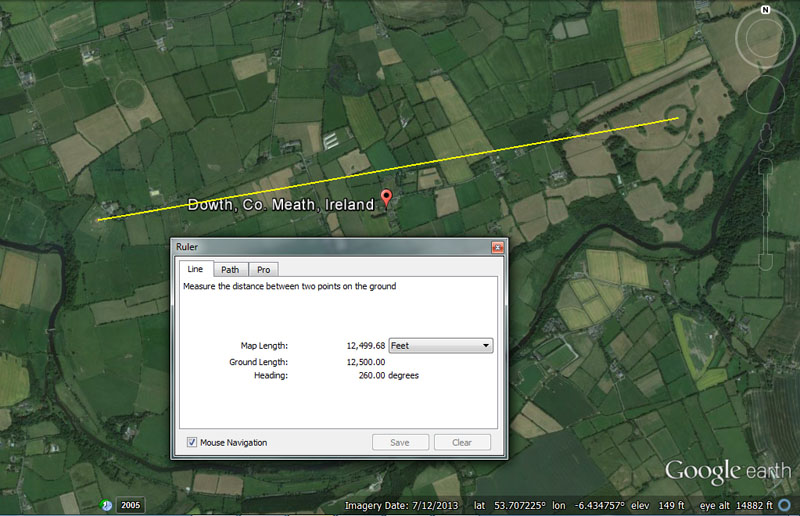
With the due North outer marker, Slieve Gullion Mountain, established for accurate degree angle readings from the centre of Dowth Henge, it was time to set up a surveyor's baseline of known length and angle within the Boyne River Valley itself, from which accurate triangulation calculations could be made.
Using exploitable hillock features in the available landscape, it was decided that a baseline of 12500' was achievable, lying on an angle of 260-degrees from Dowth Henge, for a return angle to the henge of 80-degrees. At the western end of that baseline, Knowth passage & chambered mound was carefully built so that it's epicentre sat precisely at the WSW end of the baseline.
From Knowth mound's centre rooftop platform, Slieve Gullion Mountain's summit cairn stood @ an intended, coded angle of 4.6-degrees azimuth, and 29 & 1/6th English miles distant.
DOWTH HENGE & NEOLITHIC STRUCTURES IN CLOSE PROXIMITY
Having shown several examples of sites that stand far-off from Dowth Henge at coded distances and angles, let's return to the henge and concentrate on structures within the Boyne River Valley itself.
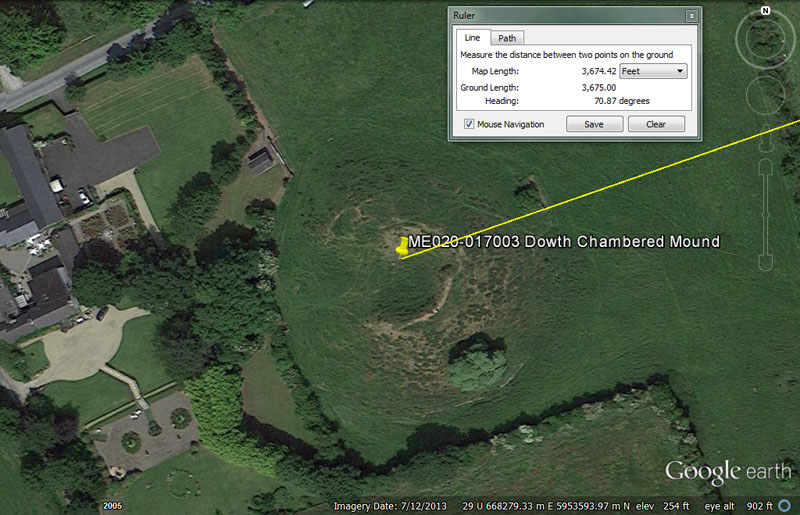
Sitting 3675' to the West of Dowth Henge at a coded return angle of 70.875-degrees (outrunning angle 250.875-degrees) is, formerly magnificent, Dowth passage tomb, which once approached the splendour of both Newgrange and Knowth passage tombs situated further west. Unfortunately it was all but destroyed by a botched archaeological dig in 1847-48.
The distance is .7 of a Greek mile of 5250'. It is also 7 short-stadia of 525' each or 3500 Greek feet of 12.6" each. It equates to 350 Hebrew reeds of 10.5 English feet each (126") or 1750 Assyrian cubits. The distance would be 3780 Roman overland feet of 11.66666" (11 & 2/3rds) or 756 Roman paces of 58.333333" (58 & 1/3rd). All of these known standards have been around for thousands of years and yet our archaeologists, for some insane reason, work and measure only in modern metric measurements, thus obscuring the ancient meaning in any coded distance.
The return angle @ 70.875-degrees (70 & 7/8ths), is a dynamic lunar number and the Khafre Pyramid of Egypt, which is 15/16ths the length of the Great Pyramid, is 708.75' long per side. The duration in time of 708.75-days would be exactly 2 lunar years of 354.375-days each.
The distance from the centre of Dowth Henge to a possible, secondary marker at the crown of Dowth chambered mound, could also have been configured to read 3652.5', thus coding an inflated numerical value related to the duration of the 365.25-day solar year.
Although considered to have been built as a necropolis or city for the dead, Dowth chambered mound has large souterrain systems that could have comfortably accommodated a large number of students of the astronomical and navigational arts, receiving tutorials at nearby Dowth Henge.
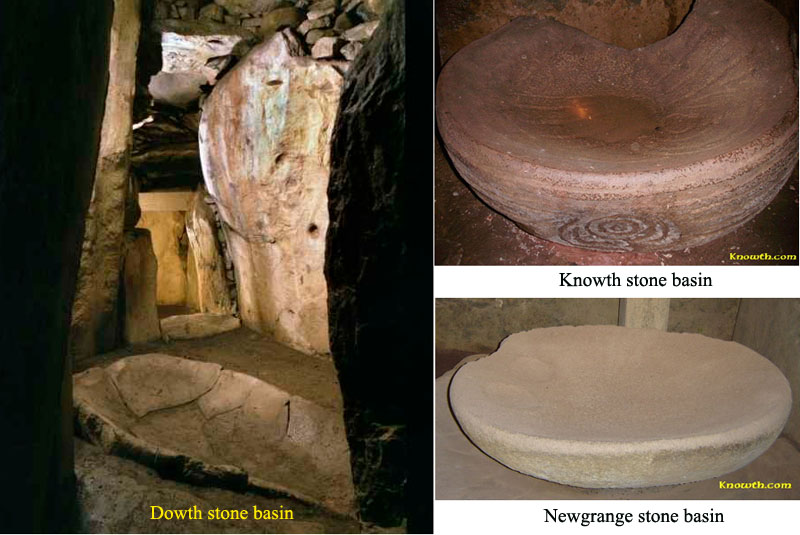
Catering for the living, rather than the dead, is strongly suggested by large basins found in each of the Boyne Valley chambered mounds, all of which could hold several gallons of drinking, cooking or washing water. Newgrange chambered mound has three of these large vessels and the one shown from that edifice measures about 3.25' X 4'. Alternatively, the Dowth basin is of such a size that it could be used as a bathtub, although its communal-living function was, undoubtedly, limited to water storage. Similar large basins or troughs, such as a very expansive one at Loughcrew, are found in other chambered mounds around Ireland as well.
Our archaeologists would probably categorise these as libation bowls for ritual worship of the dead.
SETTING UP YET OTHER HILL-TOP MARKERS FOR TRIANGULATION CALCULATIONS
Ancient Dindsenchas myths concerning Ireland and the king of the Fir-Bolgs, state the following:
Slaine, king of the Fir Bolg, and their judge, by him was its wood cleared from the Brugh. Afterwards, he died at Druim Fuar, which is called Dumha Slaine, and was buried there: and from him the hill is named Slaine. Hence it was said: Here died Slaine, lord of troops: over him the mighty mound is reared: so the name of Slaine was given to the hill, where he met his death in that chief abode'.
A tenth-century poem written by Caoílte Mac Ronáin states: 'Sláine of the Fir-Bolgs of fame t'was he by whom Tara was first raised.'

It is thought by many historians that the lower part of this mound at the summit of Slane Hill, Boyne River Valley, County Meath, Ireland, is the burial site of Sláine King of the Fir-Bolgs. The mound was, seemingly, increased in height by the army of William the Conqueror after 1066 AD and, thereafter, acted as a motte or sentinel and defensive position.
But, if there's any truth within the ancient account that, 'Sláine of the Fir-Bolgs of fame t'was he by whom Tara was first raised.', then we could plausibly assume that a significant, purpose-built surveying relationship may exist between the burial mound of Sláine and An Forradh (the royal seat on the Hill of Tara from which 142 of the high kings of Ireland ruled). The distant Hill of Tara is clearly in view from the summit of Slane Hill.
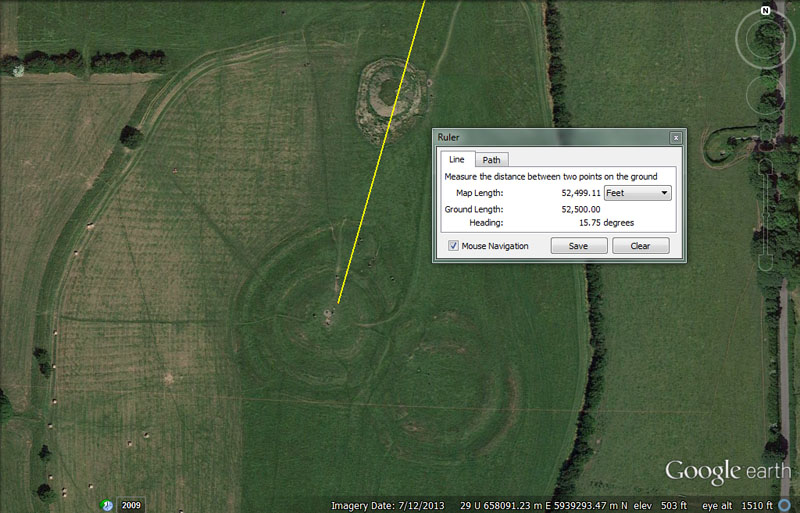
A line runs for 52500' from the burial mound of Slaine, King of the Fir-Bolgs, to the inner sanctum of An Forradh (the seat of the high kings of Ireland for thousands of years) atop the Hill of Tara. The line crosses over the Mound of the Hostages, which, in-&-of-itself, sits at a coded distance and angle from the centre of Dowth Henge.
This distance reading of 52500' is precisely 10-miles of 5250' each and the same distance would be 1/2488.32nd of the 24883.2-mile equatorial circumference of the world. The very ingenious way of remembering the equatorial circumference was to describe it as 12 X 12 X 12 X 12 X 1.2-miles (of 5250') = 24883.2-miles.
The return angle (15.75-degrees) to the burial mound of King Slaine on Slane Hill is also coding that accentuates the 5250' mile. The sum of 15750' would be 3-miles of 5250'.
FROM THE MOUND OF THE HOSTAGES TO THE CHAMBERED MOUND TRIG ATOP SLIEVE GULLION MOUNTAIN.
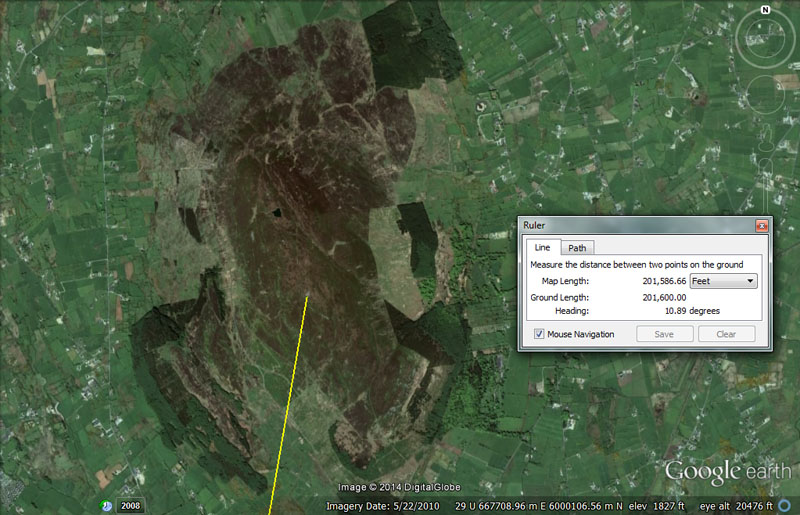
A line runs from the Mound of the Hostages, adjacent to An Forradh, to resolve here at the large white-grey patch-marker atop Slieve Gullion Mountain, in the midst of which sits the chambered cairn dormitory for ancient orienteers. The distance is coded to be 201600' @ 10.89-degrees with little or no appreciable error.
Referring back to the due North-South distance of 151200' between Dowth Henge's centre and the summit chambered cairn atop Slieve Gullion Mountain, that equated to exactly .75 of the distance from the Mound of the hostages to the same target on Slieve Gullion Mountain.
The 201600' distance is 33 & 1/3rd minutes of Earth equatorial arc and this distance from the Mound of the Hostages to Slieve Gullion's trig marker would be 1/684th of the distance around the world under the 12 X 12 X 12 X 12 X 1.2-mile (of 5250') navigational system.
It will be remembered that, under this system, 1-minute of arc was configured to be 6048' (which is 2016' X 3). The 201600' distance is exactly 30 ancient Irish miles of 6720' each, whereas the 151200' distance to the mountain from Dowth Henge is 22.5 Irish miles.
The angle of 10.89-degrees from the Mound of the Hostages to the summit trig of Slieve Gullion Mountain is also navigational coding. It will be remembered that there were two slightly different readings for the value of 1-minute of arc (6048' or 6050'), depending if one was using the navigational system incorporating either the 5250' mile or the 5280' mile. Under the 5250'-mile system 1/1200th of the equatorial circumference was 108864' and under the 5280'-mile system it was 108900'.
Hence, we have an angle of 10.89-degrees for mnemonic recall of the size of the Earth under the 5280'-mile system.